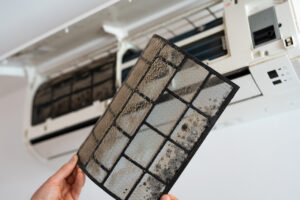There’s no question that mold has become the hot topic concerning indoor air quality. In the last several years, mold issues have escalated at alarming rates. Remediation companies have popped-up all over the country. With no certifications or any real knowledge of how mold works, these companies are charging unsuspecting homeowners and property managers thousands of dollars on work that can be either avoided or, if understood, treated themselves.
Truth is, mold contamination is complicated because finding the cause of mold is very difficult. There is not one material, activity, or precaution you can take to prevent mold from growing inside your home. The prevention of mold and its management begins before the first brick is laid and goes on through the life of the home.
How Mold Grows
First, you need to understand how mold works. If you don’t have moisture, you don’t have mold.
Mold needs three conditions to grow:
- Relative humidity is 50 percent or higher.
- The temperature is 40 degrees or higher.
- Biodegradable material is present.
Mold can also grow if there are enough dust and other organic materials that have collected on the surface of brick, stone, glass, plastics, or aluminum ductwork.
Insulation is the Best for Mold Prevention
Insulation is one of the most powerful tools for mold prevention. It manages the building’s temperature and moisture, which reflects the lack of mold growth. If installed the right way, insulation will support dry, temperature-controlled conditions that inhibit mold growth. If installed the wrong way, it can promote the development of mold growth deep within the building’s walls.
Mold prevention comes by way of elimination of the source of moisture.
Insulation is your first defense in mold prevention.
Selecting the best insulation is the first step in creating a dry, properly–functioning indoor environment. There are a multitude of different types of insulation available from fiberglass, cellulose, or icynene to rigid or flexible. Selecting the right insulation for the environment it’s being used in is essential in preventing mold growth. The National Insulation Association has a very informative website that can be very helpful when making decisions about insulation.
There are, of course, different types of insulation where mold can grow, which causes a big debate among the industry.
It can grow on different materials in varying degrees. Architects, contractors, and salespeople at places such as Home Depot and Lowe’s all have a different take on which type of insulation to use.
If there is any doubt as to whether there could be a moisture problem, take these factors into consideration.
Fiberglass, a non-biodegradable substance is resistant to mold. With its sharp, ground glass, mold spores puncture before they can attach to it. Mold can grow on the fiberglass insulation backing, which is made of paper and is a mold food source. Fiberglass insulation without backing may be the best choice.
Cellulose insulation is constructed of ground paper, which is an ideal food source for the growth of mold if it becomes wet. Cellulose should only be used when it’s absolutely certain it will not get wet.
There is insulation around ductwork and pipes, rigid foam, foiled, and closed-cell insulation. I have even found duck feathers stuffed into a wall cavity. That certainly brings a new meaning to “duck work.”
Select Your Best Insulation Option
In short, when selecting new insulation or checking on your current insulation, you need to carefully consider the environment and the circumstances that the insulation will be used in. Insulating attics are completely different than insulating a crawl space as well as insulating the cavity of a wall in your home. If there’s a way moisture can get between the outside and inside walls, the insulation will get wet. Some take a long time to dry and if there’s a vapor barrier, you can end up removing a lot of your wall and possibly the ceiling and floor because of mold.
Bottom-line, avoiding water intrusion is the basic rule of mold prevention. Water is a homeowners biggest enemy. If you don’t have moisture, you don’t have mold. An inspection of the exterior walls, roof, attic, crawlspace, and basements can help identify potential problems before they start.
This is just a small amount of information from a whole industry that is part of the first line of defense against mold in your home or commercial building. Insulation plays a huge part in prevention from protecting us from our worst enemy, water!
Be diligent and informed when it comes to mold prevention and seek a professional who knows how to battle the problem efficiently and most importantly, completely.
For more information regarding mold diagnostics or to schedule a moisture check-up, call us today!







